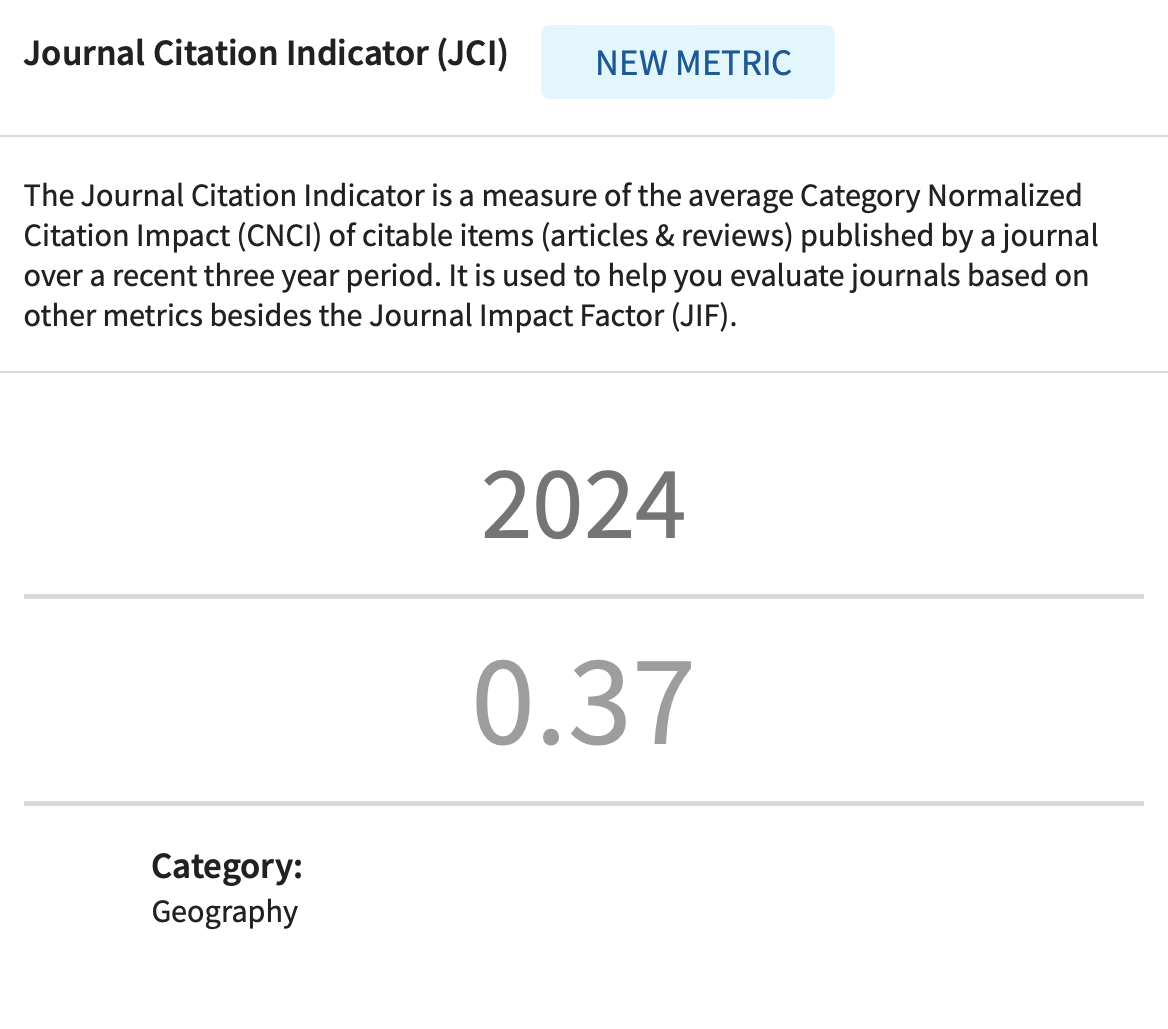FUTURE RESEARCH TOPIC PROSPECT DEALING WITH THE “FLOOD SEVERITY” TERM: A SYSTEMATIC LITERATURE REVIEW
DOI:
https://doi.org/10.2298/IJGI240903006SKeywords:
flood severity, systematic literature review, bibliometric analysis, clusteringAbstract
Most recent flood prediction studies focus on the probability and frequency of a flood at a specific location or flood vulnerability prediction. However, their results often lack flood magnitude or severity information. Therefore, severity levels are highly imperative for further research in floods, such as their mapping and prediction. This study has involved various stages, such as developing the literature selection protocol in obtaining the expected papers, searching the literature by protocol implementations, and results interpretation. The search results were 537 articles; the selected rigorously peer-reviewed articles were then bibliometrically analyzed. The limited flood severity-related research was proven by the “severity” term detected in fewer than five terms. Recommendations of flood severity-related research can be categorized into seven clusters based on the term co-occurrences. Those clusters consist of: 1) urban flood, 2) flood disaster management, 3) adaptability and prediction, 4) land use and urban planning, 5) natech and mitigation, 6) climate change, and 7) ecosystem services and resilience. There is a research gap in geographical terms for several countries classified as the world’s top 10 at risk of flood, such as China, India, Bangladesh, Indonesia, Pakistan, and others. The urgent prior research guidelines are to trigger further future research on flood severity levels. Future research recommendations will give better contribution and consideration to flood risk management rather than merely vulnerability zonation as they also imply the possible impacts of predicted floods.
Article metrics
References
Arsawan, I. W. E., Hariyanti, N. K. D., Azizah, A., Suryantini, N. P. S., & Darmayanti, N. P. A. (2024). Internet of things towards environmental performance: a scientometrics and future research avenues. E3S Web of Conferences, 501, Article 01011. https://doi.org/10.1051/e3sconf/202450101011
Chan, S. W., Abid, S. K., Sulaiman, N., Nazir, U., & Azam, K. (2022). A systematic review of the flood vulnerability using geographic information system. Heliyon, 8(3), Article e09075. https://doi.org/10.1016/j.heliyon.2022.e09075
Conte, N. (2022, September 14). Mapped: Countries With the Highest Flood Risk. Visual Capitalist. https://www.visualcapitalist.com/countries-highest-flood-risk/
Costache, R., Crăciun, A., Ciobotaru, N., & Bărbulescu, A. (2024). Intelligent Methods for Estimating the Flood Susceptibility in the Danube Delta, Romania. Water, 16(23), Article 3511. https://doi.org/10.3390/W16233511
Costache, R., Pal, S. C., Pande, C. B., Islam, A. R. M. T., Alshehri, F., & Abdo, H. G. (2024). Flood mapping based on novel ensemble modeling involving the deep learning, Harris Hawk optimization algorithm and stacking based machine learning. Applied Water Science, 14, Article 78. https://doi.org/10.1007/s13201-024-02131-4
Diakakis, M., Deligiannakis, G., Antoniadis, Z., Melaki, M., Katsetsiadou, N. K., Andreadakis, E., Spyrou, N. I., & Gogou, M. (2020). Proposal of a flash flood impact severity scale for the classification and mapping of flash flood impacts. Journal of Hydrology, 590, Article 125452. https://doi.org/10.1016/j.jhydrol.2020.125452
Feng, G.-L., Yang, J., Zhi, R., Zhao, J.-H., Gong, Z.-Q., Zheng, Z.-H., Xiong, K.-G., Qiao, S.-B., Yan, Z., Wu, Y.-P., & Sun, G.-Q. (2020). Improved prediction model for flood-season rainfall based on a nonlinear dynamics-statistic combined method. Chaos, Solitons & Fractals, 140, Article 110160. https://doi.org/10.1016/J.CHAOS.2020.110160
Feng, Y., Brenner, C., & Sester, M. (2020). Flood severity mapping from Volunteered Geographic Information by interpreting water level from images containing people: A case study of Hurricane Harvey. ISPRS Journal of Photogrammetry and Remote Sensing, 169, 301–319. https://doi.org/10.1016/j.isprsjprs.2020.09.011
Gaume, E., Bain, V., Bernardara, P., Newinger, O., Barbuc, M., Bateman, A., Blaškovičová, L., Blöschl, G., Borga, M., Dumitrescu, A., Daliakopoulos, I., Garcia, J., Irimescu, A., Kohnova, S., Koutroulis, A., Marchi, L., Matreata, S., Medina, V., Preciso, E., . . . Viglione, A. (2009). A compilation of data on European flash floods. Journal of Hydrology, 367(1–2), 70–78. https://doi.org/10.1016/J.JHYDROL.2008.12.028
Ghosh, A., & Dey, P. (2021). Flood Severity assessment of the coastal tract situated between Muriganga and Saptamukhi estuaries of Sundarban delta of India using Frequency Ratio (FR), Fuzzy Logic (FL), Logistic Regression (LR) and Random Forest (RF) models. Regional Studies in Marine Science, 42, Article 101624. https://doi.org/10.1016/j.rsma.2021.101624
Gokul Raj, S. N., Chitra, P., Silesh, A. K., & Lingeshwaran, R. (2023). Flood Severity Assessment Using DistilBERT and NER. In P. Singh, D. Singh, V. Tiwari, & S. Misra (Eds.), Machine Learning and Computational Intelligence Techniques for Data Engineering (pp. 391–402). Springer. https://doi.org/10.1007/978-981-99-0047-3_34
Govindasamy, P., Mohd Noor, A., Mohd Isa, N. J., Olmos, A., & Green, K. (2020). A Practical Guide to Conducting Systematic Literature Review Using R Software. Evaluation Studies in Social Sciences, 1(1), 35–43. https://ejournal.upsi.edu.my/index.php/ESSS/article/view/7686
Hakim, D. K., Gernowo, R., & Nirwansyah, A. W. (2024). Flood prediction with time series data mining: Systematic review. Natural Hazards Research, 4(2), 194–220. https://doi.org/10.1016/J.NHRES.2023.10.001
Horton, A. J., Nygren, A., Diaz-Perera, M. A., & Kummu, M. (2021). Flood severity along the Usumacinta River, Mexico: Identifying the anthropogenic signature of tropical forest conversion. Journal of Hydrology X, 10, Article 100072. https://doi.org/10.1016/j.hydroa.2020.100072
Hu, Z., Wang, L., Tang, H., & Qi, X. (2017). Prediction of the future flood severity in plain river network region based on numerical model: A case study. Journal of Hydrodynamics, 29(4), 586–595. https://doi.org/10.1016/S1001-6058(16)60771-0
Kanwal, S., Muram, F. U., & Javed, M. A. (2024). Systematic review on contract-based safety assurance and guidance for future research. Journal of Systems Architecture, 146, Article 103036. https://doi.org/10.1016/j.sysarc.2023.103036
Kjeldsen, T. R. (2010). Modelling the impact of urbanization on flood frequency relationships in the UK. Hydrology Research, 41(5), 391–405. https://doi.org/10.2166/NH.2010.056
Kobiyama, M., & Goerl, R. F. (2007). Quantitative method to distinguish flood and flash flood as disasters. SUISUI Hydrological Research Letters, 1, 11–14. https://doi.org/10.3178/suisui.1.11
Koval, V., Arsawan, I. W. E., Suryantini, N. P. S., Kovbasenko, S., Fisunenko, N., & Aloshyna, T. (2023). Circular Economy and Sustainability-Oriented Innovation: Conceptual Framework and Energy Future Avenue. Energies, 16(1), Article 243. https://doi.org/10.3390/EN16010243
Li, Z., Gao, S., Chen, M., Zhang, J., Gourley, J. J., Wen, Y., Yang, T., & Hong, Y. (2023). Introducing Flashiness-Intensity-Duration-Frequency (F-IDF): A New Metric to Quantify Flash Flood Intensity. Geophysical Research Letters, 50(23), Article e2023GL104992. https://doi.org/10.1029/2023GL104992
Mosavi, A., Ozturk, P., & Chau, K. (2018). Flood prediction using machine learning models: Literature review. Water, 10(11). Article 1536. https://doi.org/10.3390/w10111536
Murray, S. J., Smith, A. D., & Phillips, J. C. (2012). A Modified Flood Severity Assessment for Enhanced Decision Support: Application to the Boscastle Flash Flood of 2004. Weather and Forecasting, 27(5), 1290–1297. https://doi.org/10.1175/WAF-D-12-00033.1
Musson, R. M. W., Grünthal, G., & Stucchi, M. (2010). The comparison of macroseismic intensity scales. Journal of Seismology, 14(2), 413–428. https://doi.org/10.1007/s10950-009-9172-0
Muthu, K., & Ramamoorthy, S. (2025). Urban flood risk assessment using fuzzy logic and real-time flood simulation model – A geomatics techniques. Earth Science Informatics, 18, Article 72. https://doi.org/10.1007/s12145-024-01505-1
Ngcamu, B. S. (2023). Application of the disaster management cycle and climate change: Studying flood disasters in South Africa. Social Sciences & Humanities Open, 8(1), Article 100657. https://doi.org/10.1016/j.ssaho.2023.100657
Notti, D., Giordan, D., Caló, F., Pepe, A., Zucca, F., & Galve, J. P. (2018). Potential and Limitations of Open Satellite Data for Flood Mapping. Remote Sensing, 10(11), Article 1673. https://doi.org/10.3390/RS10111673
O’Doherty, D., Dromey, M., Lougheed, J., Hannigan, A., Last, J., & McGrath, D. (2018). Barriers and solutions to online learning in medical education – an integrative review. BMC Medical Education, 18, Article 130. https://doi.org/10.1186/s12909-018-1240-0
Pandey, M. (2024). Artificial Intelligence Algorithms in Flood Prediction: A General Overview. In P. C. Pandey, R. Kumar, M. Pandey, G. Giuliani, R. K. Sharma, & P. K. Srivastava (Eds.), Geo-information for Disaster Monitoring and Management (pp. 243–296). Springer. https://doi.org/10.1007/978-3-031-51053-3_12
Rana, I. A., Asim, M., Aslam, A. B., & Jamshed, A. (2021). Disaster management cycle and its application for flood risk reduction in urban areas of Pakistan. Urban Climate, 38, Article 100893. https://doi.org/10.1016/J.UCLIM.2021.100893
René, J.-R., Djordjević, S., Butler, D., Madsen, H., & Mark, O. (2014). Assessing the potential for real-time urban flood forecasting based on a worldwide survey on data availability. Urban Water Journal, 11(7), 573–583. https://doi.org/10.1080/1573062X.2013.795237
Rentschler, J., Salhab, M., & Jafino, B. A. (2022). Flood exposure and poverty in 188 countries. Nature Communications, 13, Article 3527. https://doi.org/10.1038/s41467-022-30727-4
Roldán-Valcarce, A., Jato-Espino, D., Manchado, C., Bach, P. M., & Kuller, M. (2023). Vulnerability to urban flooding assessed based on spatial demographic, socio-economic and infrastructure inequalities. International Journal of Disaster Risk Reduction, 95, Article 103894. https://doi.org/10.1016/J.IJDRR.2023.103894
Sadler, J. M., Goodall, J. L., Morsy, M. M., & Spencer, K. (2018). Modeling urban coastal flood severity from crowd-sourced flood reports using Poisson regression and Random Forest. Journal of Hydrology, 559, 43–55. https://doi.org/10.1016/j.jhydrol.2018.01.044
Sami, G., Hadda, D., Mahdi, K., & Abdelwahhab, F. (2020). A Multi-Criteria Analytical Hierarchy Process (AHP) to Flood Vulnerability Assessment in Batna Watershed (Algeria). Analele Universităţii din Oradea, Seria Geografie, 30(1), 41–47. https://doi.org/10.30892/auog.301105-810
Scheiber, L., Hoballah Jalloul, M., Jordan, C., Visscher, J., Nguyen, H. Q., & Schlurmann, T. (2023). The potential of open-access data for flood estimations: uncovering inundation hotspots in Ho Chi Minh City, Vietnam, through a normalized flood severity index. Natural Hazards and Earth System Sciences, 23(6), 2313–2332. https://doi.org/10.5194/nhess-23-2313-2023
Schroeder, A. J., Gourley, J. J., Hardy, J., Henderson, J. J., Parhi, P., Rahmani, V., Reed, K. A., Schumacher, R. S., Smith, B. K., & Taraldsen, M. J. (2016). The development of a flash flood severity index. Journal of Hydrology, 541(Part A), 523–532. https://doi.org/10.1016/j.jhydrol.2016.04.005
Sulistyo, T., Kusumayudha, S. B., Cahyadi, T. A., & Fajar, R. A. (2025). Mobile and web-based application as a tool for flood data collection based on citizen science. Earth Science Informatics, 18, Article 344. https://doi.org/10.1007/S12145-024-01664-1
Sulistyo, T., & Respati, S. (2023). The estimation of flood area based on a few selected and weighted parameters: Case study of the Nangka river basin, Balikpapan (Indonesia). Journal of the Geographical Institute “Jovan Cvijić” SASA, 73(2), 123–137. https://doi.org/10.2298/IJGI2302123S
Tambal, S. A. R. M. A., Elsawahli, H. M. H., Ibrahim, E. I. E., & Lumbroso, D. (2024). Increasing urban flood resilience through public participation: A case study of Tuti Island in Khartoum, Sudan. Journal of Flood Risk Management, 17(2), Article e12966. https://doi.org/10.1111/JFR3.12966
Tanoue, M., Hirabayashi, Y., & Ikeuchi, H. (2016). Global-scale river flood vulnerability in the last 50 years. Scientific Reports, 6, Article 36021. https://doi.org/10.1038/srep36021
Tarasova, L., Merz, R., Kiss, A., Basso, S., Blöschl, G., Merz, B., Viglione, A., Plötner, S., Guse, B., Schumann, A., Fischer, S., Ahrens, B., Anwar, F., Bárdossy, A., Bühler, P., Haberlandt, U., Kreibich, H., Krug, A., Lun, D., . . . Wietzke, L. (2019). Causative classification of river flood events. WIREs Water, 6(4), Article e1353. https://doi.org/10.1002/wat2.1353
Tudunwada, I. Y., & Abbas, A. (2022). Flood vulnerability mapping and prediction for early warning in Jigawa State, Northern Nigeria, using geospatial techniques. International Journal of Disaster Risk Reduction, 79, Article 103156. https://doi.org/10.1016/J.IJDRR.2022.103156
van Eck, N. J., & Waltman, L. (2010). Software survey: VOSviewer, a computer program for bibliometric mapping. Scientometrics, 84(2), 523–538. https://doi.org/10.1007/s11192-009-0146-3
Wang, L., Cui, S., Li, Y., Huang, H., Manandhar, B., Nitivattananon, V., Fang, X., & Huang, W. (2022). A review of the flood management: from flood control to flood resilience. Heliyon, 8(11), Article e11763. https://doi.org/10.1016/J.HELIYON.2022.E11763
Wang, Y., & Sebastian, A. (2021). Community flood vulnerability and risk assessment: An empirical predictive modeling approach. Journal of Flood Risk Management, 14(3), Article e12739. https://doi.org/10.1111/JFR3.12739
Westgate, M. J. (2019). revtools: An R package to support article screening for evidence synthesis. Research Synthesis Methods, 10(4), 606–614. https://doi.org/10.1002/jrsm.1374
Xu, Y., Zhang, Y., Liu, K., Wu, Y., & Gao, C. (2024). Detection of flood trends and drivers in the Taihu Basin, China. Journal of Hydrology: Regional Studies, 56, Article 101990. https://doi.org/10.1016/J.EJRH.2024.101990
Yang, W., Xu, K., Lian, J., Ma, C., & Bin, L. (2018). Integrated flood vulnerability assessment approach based on TOPSIS and Shannon entropy methods. Ecological Indicators, 89, 269–280. https://doi.org/10.1016/J.ECOLIND.2018.02.015
Zhang, W., Liu, Y., Tang, W., Chen, S., & Xie, W. (2023). Rapid spatio-temporal prediction of coastal urban floods based on deep learning approaches. Urban Climate, 52, Article 101716. https://doi.org/10.1016/J.UCLIM.2023.101716
Downloads
Published
How to Cite
Issue
Section
License
Copyright (c) 2025 Journal of the Geographical Institute “Jovan Cvijić” SASA

This work is licensed under a Creative Commons Attribution 4.0 International License.











